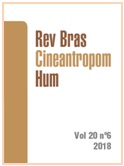Prática constante e aleatória na aprendizagem do saque do voleibol
DOI:
https://doi.org/10.1590/1980-0037.2018v20n6p598Resumo
O tipo de prática pode influenciar o que é aprendido de uma habilidade motora. Objetivou-se investigar os efeitos da prática constante e aleatória na aprendizagem do Programa Motor Generalizado e parâmetros do saque do voleibol. A amostra foi composta por 20 crianças entre 10 e 12 anos. Os participantes realizaram um pré-teste, cujo escore foi utilizado para contrabalançar dois grupos (n=10), prática constante e aleatória. Durante a fase de aquisição, o grupo aleatório realizou 252 saques de três posições diferentes, sempre indicada ao final de cada saque e o grupo controle realizou todos os saques somente de uma posição específica. O teste de retenção mostrou que ambos os grupos aprenderam o Programa Motor Generalizado, mas a prática aleatória conduziu para uma melhor aprendizagem dos parâmetros, resultante da prática variada. Durante a prática de habilidades motoras esportivas, apesar de as práticas constante e aleatória melhorarem a aprendizagem do Programa Motor Generalizado, somente a prática aleatória melhora a aprendizagem dos parâmetros da habilidade motora.Referências
Del Rey P, Wughalter EH, Whitehurst M. The effects of contextual interference in females with varied experience in open sport skill. Res Q Exerc Sport 1982;53(2):108-15.
French KE, Rink JE, Werner PH. Effects of contextual interference on retention of three volleyball skills. Percept Mot Skill 1990;71:179-86.
Shea JB, Morgan RL. Contextual interference effects on the acquisition, retention, and transfer of a motor skill. J Exp Psychol 1979;5(2):179-87.
Fialho JVAP, Benda RN, Ugrinowitsch H. The contextual interference effect in a serve skill acquisition with experienced volleyball players. J Hum Mov Stud 2006;50:65-78.
Saemi E, Porter JM, Varzaneh AG, Zarghami M, Shafinia P. Practicing along the contextual interference continuum: a comparison of three practice schedules in an elementary physical education setting. Kinesiology 2012;44(2):191-8.
Wright DL, Shea CH. Manipulating generalized motor program difficulty during blocked and random practice does not affect parameter learning. Res Q Exerc Sport 2001;72(1):32-8.
Lage GM, Alves MAF, Oliveira FS, Palhares LR,Ugrinowitsch H, Benda RN. The combination of practice schedules: effects on relative and absolute dimensions of the task. J Hum Mov Stud 2007;52:21-35.
Lai Q , Shea CH, Wulf G, Wright DL. Optimizing generalized motor program and parameter learning. Res Q Exerc Sport 2000;71(1):10-24.
Lai Q , Shea CH. Generalized motor program (GMP) learning: effects of frequency of knowledge of results and practice variability. J Mot Behav 1998;30(1):51-9.
Shea CH, Lai Q , Wright DW, Immink M, Black C. Consistent and variable conditions: effects on relative and absolute timing. J Mot Behav 2001;33(2):139-52.
Januário MS, Ugrinowitsch H, Lage GM, Vieira MM, Benda RN. Effect of the combination of different practice schedules on acquisition of motor skills. Rev Bras Cien Esporte 2014;36:5758-5773.
Hebert EP, Landin D, Solmon MA. Practice schedule effects on the performance and learning of low- and high-skilled students: an applied study. Res Q Exerc Sport 1996;67(1):52-8.
Wulf G, Shea CH. Principles derived from the study of simple skills do not generalize to complex skill learning. Psychon Bull Rev 2002;9(2):185-211.
Schmidt RA. A Schema theory of discrete motor skill learning. Psychol Rev 1975;82(4):225-60.
Meira Jr, CM. Validating a checklist for qualitative analysis of volleyball serve. Motriz: J Phys Ed 2003;9(3):153-60.
Costa CLA, Bandeira PFR, Matos CO, Cruz MP, Ugrinowitsch H. Construct validity and reliability of a checklist for volleyball serve analysis. Rev Bras Cineatropom Desempenho Hum 2017;20(1):95-101.
Santos-Naves SP, Benda RN, Junqueira AHM, Alves GM, Velloso AP, Ugrinowitsch H. The effect of distributed demonstrations in the volleyball serve learning. Rev Bras Edu Fís Esporte 2014;28(4):629-39.
Thomas JR, Nelson JK., Silverman, S. Research Methods in Physical Activity. Champaign, IL: Human Kinetics Publishers; 2011.
Green, SB. Salkind NJ. Using SPSS for Windows and Macintosh. Analyzing and Understanding Data: Pearson/Prentice Hall; 2008.
Lage GM, Ugrinowitsch H, Apolinário-Souza T, Vieira MM, Albuquerque MR, Benda RN. Repetition and variation in motor practice: a review of neural correlates. Neurosci Biobehav Rev 2015;57:132-41.
Lin CHJ, Fisher B, Winstein, C. Contextual interference effect: elaborative processing or forgetting-reconstruction? A post hoc analysis of transcranial magnetic stimulation-induced effects on motor learning. J Mot Behav 2008;40(6):578-86.
Shea JB, Zimny JB. Context effects in memory and learning movement information. In: Magill, R.A. Memory and Control of Action: ed. North-Holland Publishing Company; 1983. p. 345-366.
Moxley SE. Schema: the variability of practice hypothesis. J Mot Behav 1979;11(1):65-70.
Cross E, Schmitt P, Grafton S. Neural substrates of contextual interference during motor learning support a model of active preparation. J Cog Neuro 2007;19(11):1854-71.
Downloads
Publicado
Edição
Seção
Licença

Direitos Autorais para artigos publicados nesta revista são do autor, com direitos de primeira publicação para a revista. Em virtude da aparecerem nesta revista de acesso público, os artigos são de uso gratuito, com atribuições próprias, em aplicações educacionais e não-comerciais, desde que seja dada a atribuição. Esta obra foi licenciada com uma Licença Creative Commons Atribuição 4.0 Internacional - CC BY


